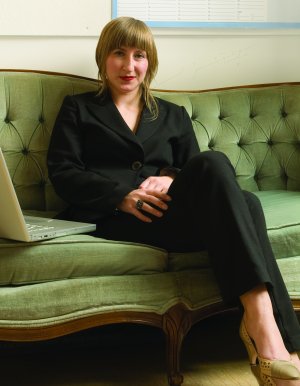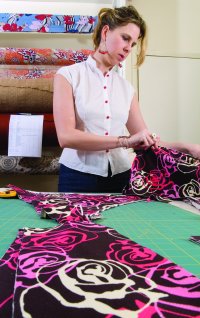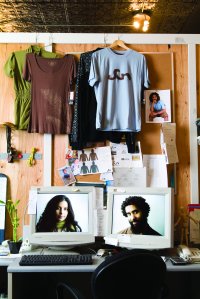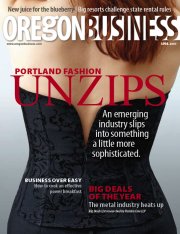The next generation of Portland’s fashion designers is creating a new look — and a new industry.
 Fashion statement
Fashion statement
The next generation of Portland’s fashion designers is creating a new look — and a new industry.
By Christina Williams
Among the Prada, Pucci and Ermenegildo Zenga on the racks of upscale fashion retailer Mario’s new Tigard Bridgeport Village store, Mario’s 3.10, is the spring line from an unknown young fashion designer named Anna Cohen.
Her modern, street-savvy look fits in well with the many Italian designers favored by Mario’s, but while Cohen trained in Italy, her studio is a lot closer to home: Northeast Portland.
There was a bit of luck involved in getting the 29-year-old in the door — a well-timed introduction from a family friend — but don’t think for a minute that Sharon Wilkstrom, Mario’s buyer, did her any favors. She doesn’t make a habit of supporting local designers: Cohen is the only one she can think of. “It fits the Mario’s aesthetic,” she says of her line. “That she’s local is just an added bonus.”
Cohen is part of a new generation of Oregon designers determined to compete with the biggest names in fashion — and create a new industry in the process.
Long a state known for its Pendleton plaids, swoosh-studded sportswear and all manner of waterproof jackets, Oregon — specifically Portland — is on the front end of a fashion revolution, carving out a niche that taps its resident design talent and environment-loving ethic to create clothes the world is clamoring to buy.
 Anna Cohen trained in Italy and her eponymous clothing line is attracting international attention. Anna Cohen trained in Italy and her eponymous clothing line is attracting international attention.Photo by Stuart Mullenberg |
And, for the most part, these clothes don’t resemble raincoats or tracksuits.
“People tell me ‘I really love your clothes but they’re not Portland,’” says Adam Arnold, a 35-year-old maker of classic-inspired men’s and women’s clothing.
Arnold moved from Seattle back to his hometown of Portland in 2002, where he found more inspiration and a better market. While he doesn’t have the ambition to expand his line beyond what he can sew himself, he sees the potential for those who do.
“In Portland there is a new design sense that is growing and building. That’s what’s exciting to me, that’s what keeps me here: the possibility of something new,” Arnold says. “Any designer who isn’t taking full advantage of that possibility is completely stupid right now.”
Portland offers a thriving scene of independent boutiques and designers, low overhead and a growing global reputation as a creative and sustainable hub. The Art Institute of Portland’s apparel design classes continue to swell — there are 300 students in the program — and in Corvallis, Oregon State University has the only master’s and Ph.D. programs in apparel design west of the Rockies.
It’s impossible to say how many fashion designers are working in Oregon. There’s no one association and many are fiercely independent, but evidence indicates their numbers are growing.
“Portland has become a mecca” for young designers, says Leslie Burns, chair of the department of design and human environment at OSU. “It really is becoming known in terms of the fashion world.”
Burns, lead author of the textbook The Business of Fashion: Designing, Manufacturing and Marketing, which is used at 65 universities and design schools, says she measures a city’s fashion quotient by one main indicator: shopping.
“I find things in the boutiques as well as stores like Mario’s that I can’t even find in Seattle,” Burns says. “I’d rather shop in Portland than any other city.”
Most industry watchers trace Portland’s boutique boom to Seaplane, which opened on Southeast Belmont in 2000. Seaplane was DIY Portland at its best, with reconstructed vintage clothing and edgy fashion shows. Seaplane sold, still does, the work of 10 or so local designers and has made it onto the radar of some national magazines and into the itinerary of fashion-seeking tourists.
In 2005 Seaplane moved over the river and onto Northwest 23rd Avenue in an effort to get in front of more deep-pocketed shoppers. Kate Townsend, who co-owns Seaplane with Holly Stadler (both also sell their designs on the racks), confesses to being tired of hosting the fashion shows they made a name for themselves putting on.
Townsend looks over the white-walled shop and the modest inventory of artful clothing in muted colors and says she’s satisfied with how things are going with Seaplane. She doesn’t have an itch to sell her clothes to a wider market. “I like the creative process,” she says.
BUT IN THE POST-SEAPLANE ERA it’s all about exporting the Portland look.
“I want to put Portland on the map internationally,” says Cohen. She’s seated in her small, dimly lit studio near the intersection of Martin Luther King Junior Boulevard and Northeast Alberta Street talking about her incredibly busy February.
Cohen’s line is made with environmentally friendly textiles — she wants her clothing to be the “canary in the coal mine,” tugging at the conscience of her high-end consumer — and the sustainable bent, a hot trend in fashion, has helped raise her profile. She was invited to show her line at Prêt a Porter, the storied Paris trade show, in a special section reserved for environmentally responsible lines. After the show, she flew to New York where she was feted as one of five socially conscious women business owners to win a $10,000 grant from upscale women’s wear maker Eileen Fisher.
“It was one of the most amazing experiences I’ve had as a business owner,” says Cohen, who was inspired by the mentoring she received from Eileen Fisher herself — who advised her to stay true to her sustainability vision — and from a company that she would like to emulate.
Cohen grew up in Molalla and Portland and, while she always had a knack for sewing and design, assumed she’d have a career in health care. But on a visit to New York at 18, she changed course after visiting the Fashion Institute of Technology. “It’s like when you have a dream and something triggers it during the day,” she explains, recalling the pull of fashion design on her subconscious.
While a student at FIT, Cohen went to Italy to study at Polimoda in Florence and ended up staying for two years, working as a textile designer, attending European trade shows and eventually landing a job at Patrizia Pepe, an Italian fashion designer whose modern urban aesthetic Cohen felt matched her own. Getting the job was a coup, but she was faced with a choice: return to the States and finish her degree or stay with Patrizia.
She chose FIT and, inspired by her desire to bring a healing touch to fashion, did her first line of sustainably constructed clothing as her senior project. In 2004 she came home to Portland and, after a short stint at Adidas designing women’s performance apparel, she began work on her eponymous line.
Cohen took her first collection to New York in October 2005 and sold it to an exclusive boutique. All told, she had $10,000 in sales for the first season. It’s been doubling each season since then.
The press, as Cohen puts it, “has been kind.” She’s been mentioned in Nylon, Lucky and Town & Country. In August, the cover of exclusive fashion trade publication Women’s Wear Daily featured a model wearing a cream colored cocktail dress made of bamboo fibers from Cohen’s spring line.
There’s nothing amateurish about her designs. Cohen’s look is street-savvy and well constructed: hemp silk pants paired with an organic cotton denim jacket for fall and a soy pencil skirt with a bamboo halter-top for spring.
Cohen is confident enough in the quality of her designs that she turned down a showroom in Los Angeles that was interested in carrying her line because she didn’t feel confident in the relationship. “It was ballsy to do it, but I’m not going to settle,” Cohen says. “I’ll find the right thing.”
WHETHER FOR SHOWROOMS OR SEWING TALENT, trips to L.A. are a necessary evil for many Portland designers.
Despite its creative vibe and abundance of design talent, Portland still lacks the production infrastructure of a mature fashion city.
“There is good inspiration for a new aesthetic here,” says Janet Jay, who worked with Diane Von Furstenberg in New York in the ’80s and now runs a creative company called Studio J in Portland. “But it’s going to take some time.”
Portland has tripped a few times in its attempts to get runway-ready. The PDX Fashion Incubator, a nonprofit set up to help young designers, folded in 2005 after three years on the scene. A group under the name PFW Productions continued the incubator’s tradition of putting on Portland Fashion Week (they’re busy planning the fifth annual show, which will focus on sustainability), but last year they competed with another fashion week put on by a group of designers called The Collections with some silly debates as to which was the official event.
Even Cohen says the city has a ways to go before becoming known for its fashion. “There’s been a lack of quality,” she says. “The whole thing has to shift up a notch.”
So can Portland really compete with the likes of L.A. and New York as a launching pad for a fashion line?
Portlanders Nathaniel Crissman and Rachel Turk are asking themselves the same question. Known by their label, Church & State, the duo is often mentioned as one of Portland’s hottest. Their ethereal designs include ruffle-edged dresses and bubble skirts in creamy hues. Last spring they won an honorable mention (and some type in Women’s Wear Daily) from Gen Art, which showcases up-and-coming designers.
Crissman and Turk, both 26, are committed to their line, but not necessarily to Portland. “We really like it here, but we want to have our cake and eat it too,” says Turk. “Things happen so much faster in New York. Maybe we’ll go to New York for a while and then come back.”
The community of established clothing companies in Oregon trends toward the sporty and casual, including Nike, Adidas, Pendleton, Columbia Sportswear, Hanna Andersson, Jantzen, Lucy and others. Even newcomer Nau, which is getting attention for both its sustainability mission and its edgy design, follows the outerwear tradition. These companies have their looks, and many set trends, but high fashion they aren’t.
But they do hire young designers — and serve as a training ground for those who harbor couture dreams. “Corporate is not for everybody, but it pays the student loan bills,” says Susan Bonde, director for apparel and apparel accessory design at the Art Institute. “Portland is big on apparel, not fashion.”
 Alice Dobson of Sofada showed her fall line during New York’s Fashion Week last year. Alice Dobson of Sofada showed her fall line during New York’s Fashion Week last year.Photo by Stuart Mullenberg |
Alice Dobson is actually OK with that. She prefers the title apparel manufacturer to fashion designer, even though she last year showed her wares in a runway show during New York’s Fashion Week.
Dobson, who grew up in Gearhart and sewed clothes for herself to make up for the lack of shopping options, attended the Fashion Institute of Design and Merchandising in Los Angeles. She was prompted to start her own line when, upon returning to Portland just after 9/11, she couldn’t get a job with any of the local clothing companies.
“I’d heard about Seaplane so I decided to just start sewing again,” Dobson says. “The clothes started selling really well.”
Encouraged, she took out a lease on a tiny storefront on Northeast Fremont Street, named it after her clothing line, Sofada (it’s a variation on the Portuguese word for “naughty”) and opened for business. “I took out a really bad loan to do it, but I paid it off in seven months,” Dobson says.
“I want to make money, that’s why I design clothing that’s wearable,” says the 29-year-old. “I get ripped on sometimes as if that’s a bad thing. But I love creating a business. I love giving a job to local sewers.”
Last winter, Dobson, six months pregnant, and her husband scraped together $30,000 to take advantage of a connection and get Sofada’s fall ’07 line shown at an off-Fashion Week tent in New York’s Chelsea neighborhood. “I was kind of getting bored,” she says. “I wanted to get out of Oregon and Washington.”
The show paid off: Dobson was summoned for a private audience with editors at Vogue while she was in New York and when she got back the orders from boutique buyers came in — right about when the baby arrived in June. She’s been playing catch-up since then and hopes to return to New York’s Fashion Week with her spring line in October. Right now she’s working to keep the 20 stores that sell Sofada happy and plans to do $100,000 in wholesale business this year.
SOFADA IS FOLLOWING IN THE FOOTSTEPS of another line of wearable, pretty women’s clothing from the Portland area, Michelle DeCourcy.
DeCourcy started her company at her kitchen table in 2000 and now has six employees, a store in the Pearl District and a wholesale business that brought in $500,000 last year. She’s looking at growing her retail operation in markets including Seattle, Santa Barbara and Arizona.
“I can see Portland becoming a large center for fashion,” DeCourcy says. “We’re so set up to have a garment industry.”
 Amy Christensen (left) designs the street-savvy looks for Sameunderneath, which was started by her husband Ryan (right). Amy Christensen (left) designs the street-savvy looks for Sameunderneath, which was started by her husband Ryan (right).Photo by Stuart Mullenberg. |
The founder of Sameunderneath, Ryan Christensen, plans to be a part of that industry. His company’s streetwise designs aren’t high fashion, but they aren’t part of the Gortex set either. Call it clothing on a mission.
While studying education at Portland State University, the native Californian developed a curriculum that would teach kids about tolerance of people who look different on the outside.
Then he had a better idea. “Kids are very keen about judging each other by the brands they wear,” says Christensen, 30. So he built what he calls a lifestyle brand that’s all about being open minded.
Sameunderneath’s flagship store, design studio and headquarters are nestled at the intersection of North Shaver and North Mississippi Avenue. The space is cozy and the store dachshund, Bonnie, waddles lazily about to a reggae beat.
It may look calm, but the company is simmering. Christensen’s wife and the line’s head designer, Amy Christensen, is at the computer in the back room, catching up after several days on the road to a trade show in Las Vegas where Sameunderneath’s streetwear line was shown in a juried selection of emerging designers alongside the likes of Diesel, DKNY, Theory and other brands.
Christensen says they brought home twice as many orders as they did from their last trade show. Thanks in part to a new team of sales reps covering the entire country, Australia, New Zealand and parts of eastern Asia, Sameunderneath is on track to pull in $1 million in sales this year. Not bad for a business that through 2004 was just peddling novelty T-shirts at events, never making more than $5,000 in a year.
In 2005, Christensen raised $125,000 from friends and family and launched cut-and-sew production (both in-house and overseas) on unique Sameunderneath designs. Along the way, the company adopted the use of all sustainable fabrics. Sales hit $55,000 in ’05 and $345,000 in ’06. The brand became a media favorite, getting coverage in publications including GQ and Women’s Wear Daily and ending up in the wardrobe of a few celebrities, including singer Nelly Furtado.
With a tricked out website, an on-call street marketing brigade, a MySpace page, and regular YouTube videos, Sameunderneath is definitely homed in on a younger crowd, though the prices of the jackets ($300), T’s ($52) and pants ($132) require an income of some means.
But Christensen is unabashed in his mission to save the world and he’s convinced that Portland is the best place to do it from.
“I don’t think I could have started this in any other city, to be honest,” Christensen says. “Here I’m able to produce something real. In New York or L.A. it would just become a sales gimmick.”
Whether it’s an authenticity that appeals to street fashion connoisseurs or the green reputation that gives environmentally friendly designs an extra dose of credibility, Portland’s profile is on the rise internationally. If this generation of designers can take advantage of that and sell their looks to the world, there’s a new industry in town.
Have an opinion? E-mail [email protected]



